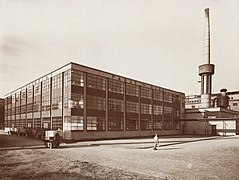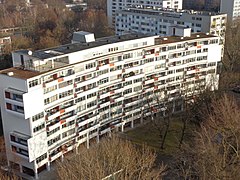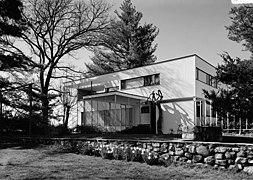Walter Gropius
Walter Adolph Georg Gropius (Berlin, German Empire, May 18, 1883-Boston, United States, July 5, 1969) was a German architect, urban planner and designer, founder of the School from the Bauhaus.
Biography
He was the son and grandson of architects. He studied architecture in Munich and Berlin, leaving in 1908 without a degree. According to his own confession, he felt overwhelmed by his difficulties with drawing. After his studies he worked for three years in the office of Peter Behrens and then went on his own. Between 1910 and 1915, the year of his marriage to Alma Mahler, he devoted himself mainly to the renovation and expansion of the Fagus factory in Alfeld. With its fine metallic structures, its large glass surfaces, its flat roofs and its orthogonal shapes, this work became a pioneer in modern architecture.
Gropius was the founder of the famous design school Bauhaus School, where students were taught to use modern and innovative materials to create original and functional buildings, furniture and objects. He held office at this school, first in Weimar and then in Dessau, from 1919 to 1928.
From 1926 Gropius devoted himself intensely to large apartment blocks, in which he saw the solution to urban and social problems. He also advocated for the rationalization of the construction industry to allow for faster and cheaper construction. He designed numerous housing complexes in which he applied his ideas.
In 1934 Gropius went into exile from Germany after suffering Nazi attacks on his work and the Bauhaus school. He lived and worked for three years in England and then moved to the United States, where he taught architecture at the Harvard School of Design. In 1946 he founded a group of young architects, which was called The Architects & # 39; Collaborative, better known as TAC. For several years he personally took care of directing and forming the group. The other partners were Norman C. Fletcher (1917-2007), Jean Bodman Fletcher (1915-1965), John C. Harkness (1916-2016), Sarah P. Harkness (1914-2013), Robert S. McMillan (1916- 2001), Louis A. McMillen (1916-1998) and Benjamin C. Thompson (1918-2002). Among the works they carried out in this period are the Rosenthal Porcelain Factory (Selb, Germany), the University of Baghdad (Baghdad) and the Packaged House System Buildings (Lincoln, Massachusetts).
He died at the age of 86.
Bauhaus Foundation
Before World War I, Gropius was already part of a movement for aesthetic renewal, represented by the Deutscher Werkbund, which sought to unite art with industrial design. At the end of the war, Gropius, in his role as director of the Sächsischen Kunstgewerbeschule (School of Arts and Crafts) and the Sächsischen Hochschule für bildene Kunst (Higher School of Fine Arts), decided to merge them into a single school that would combine academic objectives. of each one and to which an architecture section would be added.
In 1919, Walter Gropius founded a school of design, art and architecture in Weimar. Walter Gropius called the new school Staatliches Bauhaus.
In this school Gropius did not allow women to study architecture, even against the laws of the Weimar Republic that established universal education. He allowed women to participate in the textile or ceramic workshops.
The same building built for the school in Dessau manifests the most representative values of the Bauhaus. One of the principles established by the Bauhaus since its foundation was: "Form follows function". Complete construction is the goal of all visual arts. Before, the noblest function of the fine arts was to beautify buildings, they were essential components of great architecture. Today the arts exist in isolation... Architects, painters and sculptors must re-study the compositional character of the building as an entity... The artist is an exalted craftsman.
Work
Gropius's buildings reflect the purest Bauhaus style, since they are built with new materials, which give them a modern appearance, unknown at that time. Its façades are smooth and with clear lines, and are devoid of unnecessary ornamental elements. With this, Gropius has been one of the creators of the so-called "international style" in architecture.
Chronological list of their projects
- 1911-1915 Factory Fagus, Alfeld an der Leine, Germany
- 1914 Buildings of offices and factories in the Werkbund, Cologne, Germany
- 1920-1921 Sommerfeld House, Berlin, Germany
- 1920-1922 Memorial Victims Golpe State of Kapp, Weimar, Germany
- 1922 Tribune Tower Project, Chicago, USA. U.S.
- 1924 Auerbach House, Jena, Germany
- 1925-1926 Bauhaus Building, Dessau, Germany
- 1925-1926 Houses of the teachers of the Bauhaus, Dessau, Germany
- 1926-1928 Colonia Törten, Dessau, Germany
- 1927 Total Theater Project
- 1927-1929 Employment Office, Dessau, Germany
- 1928-1929 Cologne Dammerstock, Karlsruhe, Germany
- 1929-1930 Cologne Siemensstadt, Berlin, Germany
- 1934 Non-ferrous metals Section Exhibition "Deutsches Volk - Deutsche Arbeit", Berlin, Germany
- 1935-1936 Ben Levy House, London, United Kingdom
- 1938 Gropius House, Lincoln, USA. U.S.
- 1940-1941 Chamberlain Cabin, Wayland, Massachusetts, USA. U.S.
- 1948-1950 Graduate Center at Harvard University, Cambridge, USA. U.S.
- 1955-1957 Housing Block at Interbau, Berlin, Germany
- 1958-1963 Pan Am Building (now Met Life Building), New York, USA U.S.
- 1960 Complex of buildings of the Gropiusstadt, Berlin, Germany
- 1967-1970 Glass factory Thomas, Amberg, Germany
- 1976-1979 Bauhaus Archives, Berlin, Germany
Contenido relacionado
Kevin smith
Pius X
Joaquin Arderius






